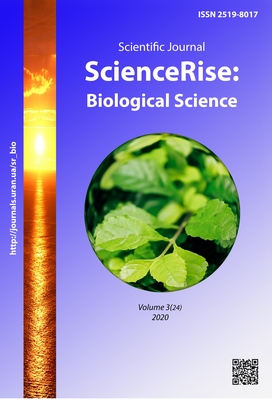Еuropean mistletoe (víscum álbum L.) in national botanical garden M.M. Grushko NAS of Ukraine: an overview of its distribution and hosts
DOI:
https://doi.org/10.15587/2519-8025.2020.213202Keywords:
Viscum album, host plants, distribution, botanical gardenAbstract
The aim. To give a brief literature review of the biological features of Viscum album L., transpiration of these plants, features of the systematic situation, distribution in the world. There was determined the distribution and general trends of the semi-parasite plant on the territory of the National Botanical Garden named after M. M. Grishka NAS of Ukraine.
Materials and methods. The research was conducted on the territory of the National Botanical Garden named after M. M. Grishka NAS of Ukraine. Visual inspection of trees and bushes for Viscum album L. was carried out, their location was determined, followed by presentation of the results on the map of the botanical garden. The degree of damage to host plants was determined.
Results. The map of the National Botanical Garden (NBG) named after M. M. Grishka of the National Academy of Sciences of Ukraine with the affected plants marked on it, is presented. A generalized list of host plants inhabited by Viscum album L. on the territory of the NBS has been compiled. The most affected plants were identified and found to belong to 7 orders of magnitude.
Conclusions. The total number (50) of plants introduced to the NBG, on which Viscum album settles, as well as the areas with the largest number of affected plants were determined. For the results of the study, we examined the V. album, which is supported to the following files Fabales, Fagales, Lamiales, Malpighiales, Malvales, Rosales and Sapindales. Identified a larger number of affected semi-parasites of cultivation - Robinia pseudoacacia, which has many plants in the NBG.
References
- Drahan, N. V., Yelpitiforov, Ye. M. (2016). Omela avstriiska – nebezpechnyi parazyt sosny zvychainoi. Suchasni tendentsii zberezhennia, vidnovlennia ta zbahachennia riznomanittia botanichnykh sadiv ta dendroparkiv. Bila Tserkva: Dendropark «Oleksandriia», 138–140.
- Mathiasen, R. L., Nickrent, D. L., Shaw, D. C., Watson, D. M. (2008). Mistletoes: Pathology, Systematics, Ecology, and Management. Plant Disease, 92 (7), 988–1006. doi: http://doi.org/10.1094/pdis-92-7-0988
- Taran, N. Yu., Batsmanova, L. M., Meleshko, A. O., Ulynets, V. Z., Lukash, O. V. (2007). Fiziolohichne obgruntuvannia metodiv profilaktyky rozpovsiudzhennia ta borotby z omeloiu biloiu u lisoparkovykh landshaftakh. Kyiv: Lenvit, 51.
- Glatzel, G., Geils, B. W. (2008). Mistletoe ecophysiology: host–parasite interactions. Botany, 87 (1), 10–15.
- Hinds, T. E., Hawksworth, F. G. (1965). Seed Dispersal Velocity in Four Dwarfmistletoes. Science, 148 (3669), 517–519. doi: http://doi.org/10.1126/science.148.3669.517
- Bulhakova, T. O. (1969). Omela ta yii roslyny-hospodari v dendroparku «Oleksandriia» AN URSR. Introduktsiia deiakykh ekzotiv i politomichnyi metod yikh vyznachennia. Kyiv: Naukova dumka, 49–50.
- Hawksworth, F. G., Wiens, D. (1996). Dwarf mistletoes: biology, pathology and systematics. Washington: Agriculture Handbook, 709. USDA Forest Service, 410.
- Kuznetsov, S. I., Levon, F. M., Klymenko, Yu. A., Pylypchuk, V. F., Shumik, M. I. (2000). Suchasnyi stan ta shliakhy optymizatsii zelenykh nasadzhen v Kyievi. Introduktsiia i zelene budivnytstvo. Bila Tserkva: Mustanh, 90–104.
- Tübeuf, K. F. (1923). Monographie der Mistel. München und Berlin: R. Oldenbourg, 832. doi: http://doi.org/10.5962/bhl.title.15456
- Watson, D. M. (2001). Mistletoe – A Keystone Resource in Forests and Woodlands Worldwide. Annual Review of Ecology and Systematics, 32 (1), 219–249. doi: http://doi.org/10.1146/annurev.ecolsys.32.081501.114024
- Rybalka, I. O., Verheles, Yu. I. (2016). Osoblyvosti poshyrennia omely biloi (Viscum album L. ) na terytorii mista Kharkova. Naukovyi visnyk NLTU Ukrainy, 26.7, 145–151.
Downloads
Published
How to Cite
Issue
Section
License
Copyright (c) 2020 Evgen Yelpitiforov, Yuriy Klymenko

This work is licensed under a Creative Commons Attribution 4.0 International License.
Our journal abides by the Creative Commons CC BY copyright rights and permissions for open access journals.
Authors, who are published in this journal, agree to the following conditions:
1. The authors reserve the right to authorship of the work and pass the first publication right of this work to the journal under the terms of a Creative Commons CC BY, which allows others to freely distribute the published research with the obligatory reference to the authors of the original work and the first publication of the work in this journal.
2. The authors have the right to conclude separate supplement agreements that relate to non-exclusive work distribution in the form in which it has been published by the journal (for example, to upload the work to the online storage of the journal or publish it as part of a monograph), provided that the reference to the first publication of the work in this journal is included.









